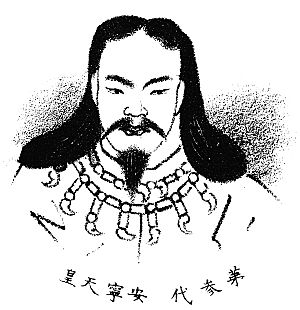Emperor Annei facts for kids
Quick facts for kids Annei |
|
|---|---|
| Emperor of Japan | |
 |
|
| Reign | legendary |
| Predecessor | Suizei |
| Successor | Itoku |
| Born | legendary |
| Died | legendary |
| Burial | Unebi-yama no hitsujisaru Mihodo no i no e no no misasagi (Nara) |
Emperor Annei (安寧天皇, Annei-tennō) was the third emperor of Japan. People believe he ruled a very long time ago.
Historians think Emperor Annei might be a legend. His name, Annei-tennō, was given to him after his time by people who lived much later. We don't have exact dates for his life or when he ruled. The names of the early emperors were officially confirmed much later, during the time of Emperor Kammu. He was the 50th ruler of the Yamato dynasty.
An old book called the Gukanshō says he ruled from a palace called Ukena-no-miya. This palace was in a place called Katashiro in Kawachi. This area is now known as Yamato Province.
About Emperor Annei
Emperor Annei is mostly known through old stories. He is considered a legend. An ancient Japanese book called the Kojiki only mentions his name and his family. Another old book, the Nihon Shoki, lists Annei as one of the "eight undocumented monarchs." This means there isn't much written history about them.
The Gukanshō book says that Annei was the son of Emperor Suizei. During Emperor Annei's time, the capital city of Japan was in Katashiha, Kawachi.
His Life and Burial Place
We don't have much information about Emperor Annei. This doesn't mean he didn't exist. It's just that very little is known about emperors before the 29th ruler, Emperor Kimmei (who lived around 509-571 AD).
There is a special place called Annei-tennō-sha in Yamato province. It is a Shinto shrine that honors the spirit (called kami) of Emperor Annei.
After His Death
Emperor Annei's official name, given after he died, was decided many centuries later. We don't know the exact place where he was buried. However, the Imperial Household Agency looks after a special memorial Shinto shrine for him. This shrine, called a misasagi, is in Nara.

Related Topics
| Preceded by Emperor Suizei |
Legendary Emperor of Japan Annei 549-511 BC (traditional dates) |
Succeeded by Emperor Itoku |
See also
 In Spanish: Annei Tennō para niños
In Spanish: Annei Tennō para niños


